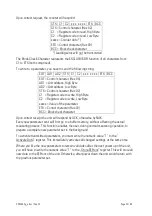
SD34002g_e.doc / Sep-13
Page 46 / 60
7.4. Example for Use of the Filter
The subsequent illustrations explain the mode of action of the Filter with different settings. For
this explanation we assume:
Sampling-Time = 10 msec
The input frequency jumps temporary up to a higher value, and after a time of 60 msec it
jumps back to the original value again
We use in sequence the filter settings 0, 1, 3 and 5
20
40
60
80
100
120
140
160
msec.
Hz
63%
100%
63%
Sampling Time = 10 msec
Time constant
= 20 msec. (with filter setting = 5)
T
a) Jump of input frequency
b) Filter = 1
c) Filter = 3
d) Filter = 5
a)
Jump: this shows how the unit would respond with the filter switched off
b)
With Filter set to "1" the unit forms a floating average value over the last two measuring
cycles. As a result, after the first sampling period we can only see 50% of the jump and
only one cycle later we can see 100%.
c)
With Filter set to "3" the unit forms a floating average value over the last eight measuring
cycles. As a result, after the first sampling period we can only see 12.5% (1/8) of the jump
and only 7 cycles later we would come up to 100%. However, since the whole jump
duration is only 6 cycles long, the display already starts to step back to the previous value
before we reached the full jumping level
d)
With Filter set to "5" the unit uses an exponential curve to smoothen the jump. Since the
Time Constant of the exponential filter always equals 2 sampling times, we reach 63% of
the jumping level after 20 msec.





























